A comprehensive guide to line-wide DC Events – including story overviews, characters, issue lists, and how they can be read via omnibuses, hardcovers, and trade paperbacks. Part of Crushing Krisis’s Crushing Comics. Last updated March 2017 with titles scheduled for release through October 2017.
Crisis.
It’s a word inextricably linked with DC Comics ever since their landmark 1985 series Crisis on Infinite Earths, the birth over three decades of sprawling, line-wide events that often keep the promise that “nothing will ever be the same.”
That’s because the biggest of DC’s big events are borne out of necessity. They often are charged with a very practical storytelling goal.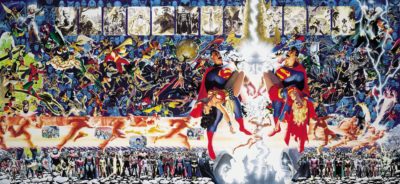
Most fans know that Crisis merged myriad competing versions of heroes and continuity down to a single set by its end in 1986, resulting in historic relaunches of Wonder Woman and Superman and the landmark Batman: Year One story. What many don’t realize is that it also brought characters whose rights DC acquired into the fold – such as Blue Beetle and The Question.
Despite Marvel beating DC to the “special event” punch with 1984’s Secret Wars, Crisis’s scope was something altogether different. It touched every ongoing title, all of which coordinated back to the spine of the event series.
After the mega success of the epic Crisis, DC produced slightly more mortal-sized events in the late 80s and early 90s, including two of the biggest direct crossovers ever executed in comics – The Death of Superman and Batman: Knightfall.
They were back to their timeline-shaking shenanigans with Zero Hour in 1994, and again in the 2000s with Infinite Crisis, Final Crisis, Flashpoint, Convergence, and Rebirth – all while innovating with the idea of weekly-series unfolding in near real-time with Trinity, 52, Countdown, and Brightest Day.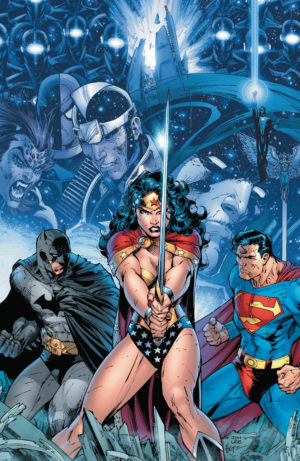
While a casual fan might look at these universe-redefining events and assume something to be very broken about the DC Universe’s mode of storytelling, over the years they have proven to be a sign of its resilience.
DC has never made the same promise as Marvel – that every story in a main title is permanently in-continuity. DC phases story concepts in and out of canon when its convenient, and in the process maintains their iconic characters and creates bigger, more sensational events that aren’t weighed down by the accumulated drag of permanent continuity.
They’re also not afraid to experiment with alternate versions of characters and newly licensed universes that – if successful – get folded into the main narrative. (They’ve done it with characters from Charleston, Milestone, and Wildstorm.)
[Patreon-2017][/Patreon-2017]
This page covers all of DC’s biggest, linewide events – both those contained in their own series and direct crossovers between titles. Smaller events that were crossovers between just 2-3 titles are not included.
- 1985-86: Crisis on Infinite Earths
- 1985: DC Challenge
- 1986: Legends
- 1988: Millennium
- 1988: Cosmic Odyssey
- 1988: Invasion!
- 1991: Armageddon 2001
- 1991: War of the Gods
- 1992: Eclipso: The Darkness Within (Annuals crossover)
- 1992-93: The Death and Return of Superman
- 1993: Bloodlines & Bloodlines: Bloodbath (Annuals crossover)
- 1993-94: Knightfall
- 1994: Worlds Collide
- 1994: Elseworlds (Annuals theme)
- 1994: Zero Hour
- 1995: Year One (Annuals theme)
- 1995: Underworld Unleashed
- 1996: Legends of the Dead Earth (Annuals theme)
- 1996: The Final Night
- 1997: Pulp Heroes (Annuals theme)
- 1997: Genesis
- 1998: Ghosts (Annuals theme)
- 1998: DC One Million
- 1999: JLApe: Gorilla Warfare! (Annuals crossover)
- 1999: Day of Judgment
- 2000: Silver Age
- 2000: Planet DC (Annuals theme)
- 2001: Our Worlds at War
- 2001-02: Joker: Last Laugh
- 2004: Identity Crisis
- 2005: DC Countdown (to Infinite Crisis)
- 2005-06: Infinite Crisis
- 2006-07: Trinity, 52, and One Year Later
- 2007: Amazons Attack
- 2008-09: Final Crisis
- 2009-10: Blackest Night
- 2010-11: Brightest Day
- 2011: Flashpoint
- For DC events from 2011-2015, including Trinity War, #0 Month, Villains Month / Forever Evil, Future’s End, and Convergence, see DC New 52
- For DC events from 2016 on, see DC Rebirth
Join the Crushing On Crushing Krisis mailing list for a notice whenever this page is updated with new collections – plus, a not-more-than weekly ping about new comics content.
1985-86: Crisis on Infinite Earths
A 12-issue event series with a lengthy lead-up and line-wide tie-in issues, followed by a line-wide reboot.
The signature DC Event (and, in a roundabout way, the inspiration for this blog’s name)!
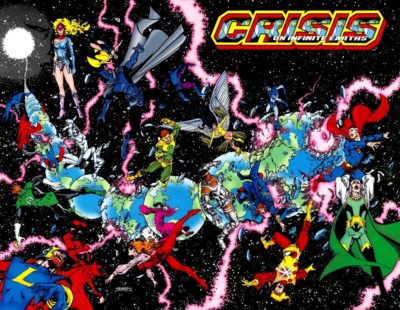 By the early 80s, DC’s line of comics had become a confusing tangle of nested universes with similar versions of key heroes. This was borne of DC doing a sort of “soft retirement” of their Golden Age heroes such that they continued to pop up from time to time … not to mention a bevy of far-flung future heroes and various other copies from when their storytelling wasn’t as strictly continuity-based.
By the early 80s, DC’s line of comics had become a confusing tangle of nested universes with similar versions of key heroes. This was borne of DC doing a sort of “soft retirement” of their Golden Age heroes such that they continued to pop up from time to time … not to mention a bevy of far-flung future heroes and various other copies from when their storytelling wasn’t as strictly continuity-based.
Crisis ended those many universes, merging them down (at first) to a single Earth and single continuity to keep things simple.
Crisis on Infinite Earths (1985) #1-12 have been collected in a variety of formats:
Crisis on Infinite Earths Absolute Edition (2005, IBSN 978-1401207120) is Crisis in DC’s massive, slipcased, bookshelf format. This edition also collects The Official Crisis on Infinite Earths Cross-Over Index (1986) #1 and The Official Crisis on Infinite Earths Index (1986) #1
Crisis on Infinite Earths Deluxe Hardcover (2015 30th Anniversary Edition, ISBN 978-1401258412) is oversized compared to standard comics and collections. This edition also collects History of the DC Universe (1986) #1-2.
Crisis on Infinite Earths Hardcover (1998, ISBN 978-1563894343)
Crisis on Infinite Earths trade paperback (2001 and forward, IBSN 978-1563897504) is kept evergreen with perpetual reprints with occasional minor changes to its trade dress.
Crisis was a truly linewide event, with every DC title acknowledging the story and many actively crossing over with the events in the mini-series. This was completely unprecedented at the time, and over the years DC has definitively documented the story order of the various tie-ins.
Prior to the event, a number of books featured minor run-up information, such as a brief cameo of Anti-Monitor. These should absolutely not be considered essential reading. Similarly, some tie-ins featured only a reddened sky to indicate the presence of Crisis at play.
Click to expand a reading order of tie-in issuesAll of DC’s titles rebooted between 1986 and 1989 in the wake of Crisis save for three – Action Comics (#584 is post-Crisis), Batman (#401 is post-Crisis), and Detective Comics (#568 is post-Crisis). Superman’s first post-crisis appearance is in DC Comics Presents #89.
1986-87: Legends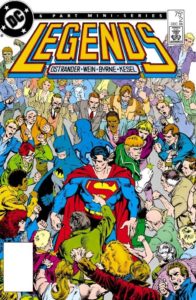
A 6-issue event series with officially numbered direct crossover issues.
Legends was DC’s first event mini-series and crossover following Crisis on Infinite Earths. It found Darkseid trying to manipulate the Earth’s people to turn on its heroes. Notably, the event launched the post-Crisis Suicide Squad, Shazam, Justice League, and The Flash.
Legends #1-6 are collected in Legends 30th Anniversary Edition trade paperback (2016, ISBN 978-1401263164) and were previously collected in a 1993 paperback (IBSN 978-1563890956).
This event had an official reading order issued by DC Comics at the time of publication, but later fan reading orders have altered it for a smoother read [those alterations are in brackets].
Click to expand a reading order of tie-in issues1988: Millennium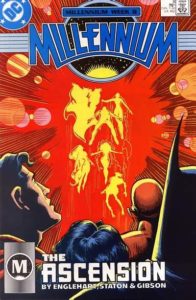
A 8-issue weekly event series with tie-in issues branded “Week #” each week.
The Guardians of the Universe – the blue-skinned group that governs the Lanterns – depart our dimension, leaving behind a single member to create a new council of guardians comprised entirely of people of Earth.
When the villainous, robotic Manhunters find out, they activate sleeper agents embedded within the friends and families of our heroes to try to assassinate the chosen guardians.
Millenium #1-8 are collected in the Millennium trade paperback (2008, ISBN 978-1401220655).
This crossover was released in weekly installments over the course of two months. That meant that each title in DC’s line had the opportunity for a pair of tie-in issues. Ultimately, the story spins off into The New Guardians (1988).
Click to expand a reading order of tie-in issues1988-89: Invasion!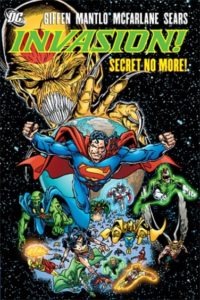
A 3-issue event series with officially listed direct crossover issues.
Invasion found a coalition of hostile alien races invading Earth to eliminate or enslave its many meta-humans.
This lead to the introduction of DC’s “metagene,” roughly the equivalent of the mutant X-factor in the Marvel Universe. It also set up Doom Patrol for Grant Morrison’s historic run.
Each issue of Invasion was an 80-page perfect-bound book!
Click to expand a reading order of tie-in issuesInvasion! #1-3 are collected in Invasion trade paperback (2016, ISBN 978-1401262198).
1991: Armageddon 2001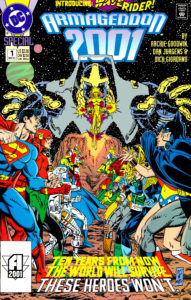
A 2-issue bookend series with officially numbered Annuals between them.
This 1991 tale begins in a potential future ruled by a ruthless despot named Monarch – a former hero. One scientist turned hero, Waverider, travels back in time to try to learn which hero becomes Monarch by peering into each of their individual futures.
As such, most of these stories qualify as “what if” tales with no impact to continuity outside of their present day framing sequences except for New Titans. Also, the ultimate outcome of the crossover was later significantly retconned (back to how it was originally intended to end!).
Click to expand a reading orderArmageddon 2001 #1-2 have not been reprinted, although some individual annuals may have been collected along with their individual series.
1991: War of the Gods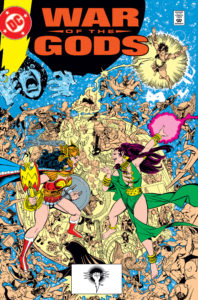
A 4-issue event series with officially numbered direct crossover issues.
A rare line-wide story centered on Wonder Woman! After the Amazons are revealed to the world, the sorceress Circe goads various other mythological pantheons to do battle across the planet.
War of the Gods #1-4 and Wonder Woman #58-62 are collected in Wonder Woman: War of the Gods trade paperback (2016, ISBN 978-1401261078).
At the time of release, all tie-in issues were bannered explicitly numbered with their place in the story – but DC made a few mistakes and omissions. Over the years, fans have confirmed this rock solid reading order.
Click to expand a reading order of tie-in issues1992: Eclipso: The Darkness Within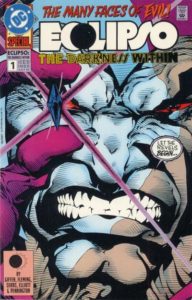
A 2-issue bookend series with officially numbered Annuals between them.
An annuals crossover in the same style as Armageddon 2001, with a series of annuals bookended by a two-issue series. The difference is that this story is in continuity and somewhat sequential. It seriously retcons Eclipso’s origins and sees him trying to conquer the Earth by possessing its mightiest heroes.
Eclipso: The Darkness Within (1992) #1-2 have not been reprinted, although some individual annuals may have been collected along with their individual series.
Eclipso continued to his own ongoing series, which has not been collected.
Click to expand a reading order of tie-in issues1992-93: The Death and Return of Superman
An event with direct and indirect crossover issues primarily in the Superman line.
By the early 90s, comic crossovers went from an occasional occurrence to a regular event. In fact, the Superman books were locked into a continual crossover, with their story ping-ponging across four books each month!
However, in 1992 DC began an event to end all events – the Death of Superman!
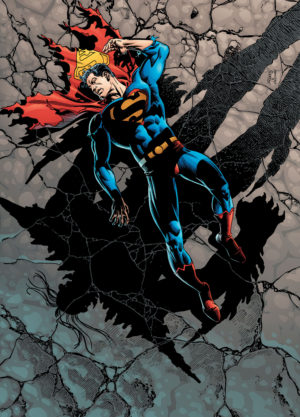 This event began with a brutal multi-issue tussle between Superman and Doomsday, continued through a funeral, and came with the shocker of four replacement Superman taking up the S-insignia. Were any of them the real thing? Were some of them actually villains?
This event began with a brutal multi-issue tussle between Superman and Doomsday, continued through a funeral, and came with the shocker of four replacement Superman taking up the S-insignia. Were any of them the real thing? Were some of them actually villains?
This is the rare mega-indulgent crossover that holds up to decades of hindsight and scrutiny. It has its occasional excesses, but it’s an interesting story that remains the reigning “Death of” champion even after DC and Marvel have killed (and resurrected) countless other heroes. It was also a terrific mystery which still holds allure today for a new generation of readers.
Superman: The Death and Return of Superman Omnibus (2013, ISBN 978-1401238643) comes the closest to containing the entire story in a single volume from Prologue to Epilogue, collecting Action Comics (1938) #683-692, Adventures of Superman (1987) #496-505, Green Lantern (1990) #46, Justice League America (1989) #69, Superman (1987) #73-82, Superman: The Legacy of Superman (1993) #1, Superman: The Man of Steel (1991) #17-26.
It omits only the funeral issues Justice League America #70 (collected in the companion Superman & The Justice League America Vol. 2) and Supergirl/Lex Luthor Special (1993) #1 (AKA “and Team Luther”), plus Action Comics Annual 5 and Superman Annual 5 (primarily part of the Bloodlines crossover).
The Death and Return of Superman Omnibus (2007, ISBN 978-1401215507) had just four fewer issues than the 2013 version and still contained the essentials of the story. Compared to the 2013 version, it omits Action Comics (1938) #685 & 686 and Adventures of Superman (1987) #496 & 499.
(Thus, it included Action Comics (1938) #683 (1 pg), 684-685, 687-691, Adventures of Superman (1987) #496 (1pg), 497-498, 500-505, Green Lantern (1990) #46, Justice League America (1989) #69, Superman (1987) #73-82, and Superman: The Man of Steel (1991) #17-26.)
Then, in 2019, DC added Action Comic #686, Adventures of Superman #500, Superman #83, Justice League of America #70, annuals from all the titles, Legacy of Superman #1, and Supergirl and Team Luthor #1. This is now the most-complete version of this book you can buy!
The Death and Return of Superman Omnibus (2019 oversize hardcover)
Collects Action Comics (1938) #684-692 & Annual 5 (and pages from #683), Adventures of Superman #497-505 & Annual 5 (and pages from #496), Superman #75-83 & Annual 5 (and pages from #73, but maybe not #74?), Superman: The Man of Steel #18-26 & Annual 2 (and pages from #17), Justice League of America #69-70, Green Lantern #46, Legacy of Superman #1, Supergirl and Team Luthor #1.A Death of Superman TPB has been kept in print since 1993, but in 2016 DC extended the line to collect the rest of this story, including all four of the issues omitted from the 2013 omnibus – two in Funeral For a Friend, and one in Reign of the Supermen, plus an extra issue of Man of Steel in The Return of Superman.
The Death of Superman (2013, 978-1401241827) collects Action Comics #684, Adventures of Superman #497, Justice League America #69, Superman #74-75, and Superman: The Man of Steel #18-19. (It also includes the final pages of Action Comics (1938) #683, Adventures of Superman (1987) #496, Superman (1987) #73, and Superman: The Man of Steel (1991) #17.)
Superman: Funeral for a Friend (2016, IBSN 978-1401266646) collects Action Comics #685-686, Adventures of Superman #498-500, Justice League America #70, Legacy of Superman #1, Supergirl/Lex Luthor Special #1, Superman (1987) #76-77, and Superman: The Man Of Steel #20-21 (This was previously collected as Superman: World Without a Superman with less content)
Superman: Reign of the Supermen (2016, ISBN 978-1401266639) collects Action Comics #687-688, Adventures of Superman #500-502, Superman (1987) #78-79 & Annual 5, Superman: The Man Of Steel #22-23, and Superman: The Man Of Steel Annual 2! (The final two volumes were previously collected as Superman: The Return of Superman with less content)
Superman: The Return of Superman (2016, ISBN 978-1401266622) collects Action Comics #689-692 and Annual 5, Adventures Of Superman #503-505 and Annual 5, Green Lantern (1990) #46, Superman (1987) #80-83, and Superman: The Man Of Steel #24-26!
The reading order of this mega event was made explicit by DC at the time – it is almost entirely linear. Some of the additional tie-in issues from above are not included in this order.
Click to expand a reading order of tie-in issues1992-95: Batman: Knightfall
An event with direct and indirect crossover issues primarily in the Batman line.
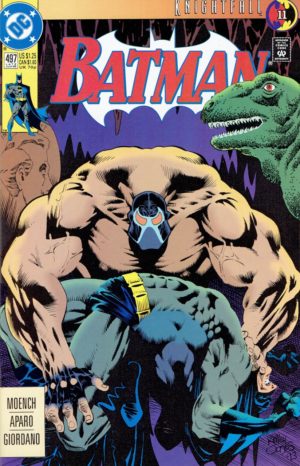 Knightfall was a story-arc constrained mainly to the Batman line of titles, but like “Death and Return of Superman” its sheer scope warrants a mention alongside other line-wide crossovers.
Knightfall was a story-arc constrained mainly to the Batman line of titles, but like “Death and Return of Superman” its sheer scope warrants a mention alongside other line-wide crossovers.
Knightfall begins with Batman experiencing a personal crisis – he’s psychologically shaken and physically battered, leaving him uncharacteristically prone to error.
This weakness is taken advantage of by Bane, who is as canny as he is muscle-bound. He incites a prison-break from Arkham Asylum and waits patiently as Batman is worn down by a capturing a hits parade of his most-famous villains. Finally, Bane makes his first direct move against Batman – which culminates in the infamous back-breaking moment that was imitated in The Dark Knight Rises.
With Batman incapacitated – maybe permanently – he makes a surprising selection for his replacement. That, an several other plot threads, continued to play out under the Knightfal umbrella for over two years before we would see Bruce Wayne back in the cowl.
Click to expand a reading order of tie-in issuesA Knightfall omnibus line began in 2017.
Batman: Knightfall Omnibus Vol. 1 Hardcover collects Batman: Vengeance Of Bane #1, Batman #484-500, Batman Shadow Of The Bat #16-18, Detective Comics #654-666, and Showcase’93 #7-8.
A 2012 series of “Batman: Knightfall” paperbacks is the most comprehensive collection of this material to date.
Batman: Knightfall, Volume 1 (2012 – 978-1401233792) collects Batman (1940) #491-500, Batman: Shadow of the Bat (1992) #16-18, Batman: Vengeance of Bane Special (1993) #1, Detective Comics (1937) #659-666, Showcase ’93 (1993) #7-8
Annual 6 is not collected. Placement is tentative. Part of Bloodlines starring Jean-Paul Valley as Batman.
Batman: Knightfall, Volume 2 – Knightquest (2012 – 978-1401235369) collects Batman (1940) #501-508, Batman: Shadow of the Bat (1992) #19-20 & 24-28, Catwoman (1993) #6-7, Detective Comics (1937) #667-675, Robin (1993) #7
Batman: Knightfall – The Search has not been collected.
Batman: Knightfall, Volume 3 – Knightsend (2012 – 978-1401237219) collects the end of Knightfall and the subsequent Prodigal storyline frmo Batman (1940) #509-510 & 512-514, Batman: Legends of the Dark Knight (1989) #62-63, Batman: Shadow of the Bat (1992) #29-30 & 32-34, Catwoman (1993) #12-13, Detective Comics (1937) #676-677 & 679-681, Robin (1993) #8-9 & 11-13, Showcase ’94 (1994) #10
Batman: Zero Hour (2017) is effectively the missing chapter of the Volume 3 trade that fits between Knightfall and Prodigal, collecting Batman #0 & 511, Batman: Shadow Of The Bat #0 & 31, Detective Comics #0 & 678, Catwoman (1993) #0 & 74, Batman: Legends Of The Dark Knight #0, and Robin (1993) #0 & 10.
A 1993 series of “Batman: Knightfall” paperbacks collected a slightly less comprehensive group of Knightfall material; they have been reprinted many times since then (sometimes with alternate trade dress).
Batman: Knightfall, Part One: Broken Bat (1993) collects Batman (1940) #491-497 and Detective Comics (1937) #659-663
Batman: Knightfall, Part Two: Who Rules the Night collects Batman (1940) #498-500, Batman: Shadow of the Bat (1992) #16-18, Detective Comics (1937) #664-666, Showcase ’93 (1993) #7-8
“The Crusade” section of Knightfall is not collected in this series
Batman: KnightsEnd (1995) collects Batman (1940) #509-510, Batman: Legends of the Dark Knight (1989) #62-63, Batman: Shadow of the Bat (1992) #29-30, Catwoman (1993) #12, Detective Comics (1937) #676-677, Robin (1993) #8-9. Does not include Catwoman (1993) #13 and Showcase ’94 #10
The Zero Hour material is not collected in this series
Batman: Prodigal (1997) collects Batman (1940) #512-514, Batman: Shadow of the Bat (1992) #32-34, Detective Comics (1937) #679-681, Robin (1993) #11-13
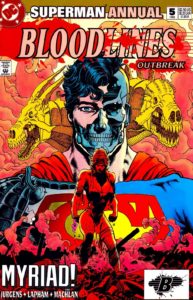 1993: Bloodlines & Bloodlines: Bloodbath
1993: Bloodlines & Bloodlines: Bloodbath
A story told across Annuals with a 2-issue series serving as the finale.
Bloodlines played out a brutal concept – that an alien race was dependent on human spinal fluid for sustenance, but a tiny fraction of humans harvested in such fashion would turn out to be superheroes themselves.
Conveniently, one or more of these humans happened to emergy in every Annual that was a part of this event.
Bloodbath #1-2 have not been reprinted, although some individual annuals may have been collected along with their individual series.
This story spun off the new comics Blood Pack, Razorsharp and the Psyba-Rats, Hitman, Anima, Loose Cannon, Argus, and Gunfire – of which only Hitman is especially notable.
Click to expand a reading order of tie-in issues1994: Worlds Collide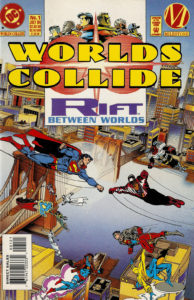
A rare direct inter-company crossover between DC’s Superman line and Milestone comics with a single titular one-shot.
In almost every instance of a crossover between two companies, the effort is self-contained in a one-shot, OGN, or mini-series. It’s largely a practical matter – a direct crossover complicates both collaboration and profits.
That’s why Worlds Collide is so interesting. It was a direct crossover between DC Comics and the African-American-owned and operated Milestone Comics.
The effects of this crossover were erased for DC heroes during Zero Hour, and then superseded for both companies by changes after Final Crisis so that Milestone characters could be incorporated into the DC Universe.
Worlds Collide has not been collected.
Click to expand a reading order of tie-in issues 1994: Elseworlds Annuals
1994: Elseworlds Annuals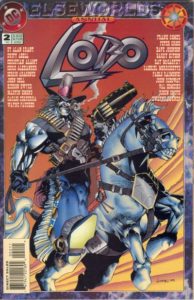
Individual stories told across the entire line of Annuals.
In a break from the prior two years, DC’s 1994 Annuals event wasn’t an a direct crossover. In fact, it could hardly be called an event so much as it was a theme. All of DC’s annuals featured alternate reality Elseworlds stories of their featured heroes.
These annuals don’t form a cohesive story (except for Adventures of Superman and Superboy) and have not been collected comprehensively, though some annuals may be collected individually.
Click to expand list of tie-in issues
1994: Zero Hour & Zero Month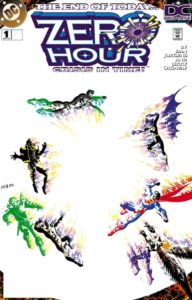
A 4-issue event series with a lengthy lead-up and line-wide tie-in issues, and accompanied by a line-wide month of #0 issues.
Zero Hour might be the most difficult DC Event to explain, but I’ll try.
Much in the same way that Crisis simplified or eliminated many of DC’s alternate universes, Zero Hour laid waste to a number of potential futures that populated books like Legionnaires and Legion of Super-Heroes. It also sought to amend many cracks in DC’s continuity that had emerged since Crisis.
That’s an editorial perspective on Zero Hour. What about the story?
A wave of chronological blankness receding from DC’s farflung future to the present day. Seemingly unrelated elements of DC’s previously-eliminated past became tangled with the present day – including a returned Batgirl. Taking advantage of the chronal decay, the villain Extant (himself the victim of several later retcons) wanted to recreate the world in his own image.
The connection between the decay of the timeline and Extant’s plans were the true story of Zero Hour, which saw a major transformation of one of DC’s most-recognizable heroes. While the plotting isn’t as rock-solid as the original Crisis, this story is shorter and considerably less cerebral, making it an easier-to-digest time crisis for fans.
Zero Hour #4-0 are collected in a Zero Hour: Crisis in Time paperback (1994 to present, 978-1563891847) kept in continuous print, along with prologue stories from Showcase ’94 (1994) #8-9
I’ve reviewed several reading orders of Zero Hour on the web, but none of them have it quite right – so I pulled out my issues to try to find a better way to do things! A number of DC’s future history titles acted as teasers to Zero Hour prior to the event – they are not listed here until the “End of an Era” crossover that marked their respective finales.
Click to expand a reading order of tie-in issues1995: Year One Annuals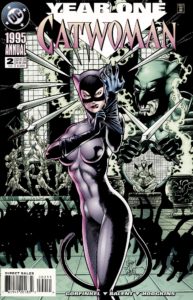
Individual stories in different continuities told across the entire line of Annuals.
Zero Hour did something distinctly different than Crisis on Infinite Earths when it came to DC’s ongoing history. Aside from DC’s future heroes, continuity didn’t see the massive, sweeping alterations that came along with Crisis merging and simplifying multiple universes. Instead, there were a series of minor adjustments.
To implement those adjustments – and to make clear to fans just what they were – all of DC’s annuals in the following year were labeled as “Year One.” This story name had been popularized by the post-Crisis Frank Miller Batman story with exactly the same goal.
These annuals don’t form a cohesive story and have not been collected comprehensively, though some annuals within a single line (like Batman) may go together.
Click to expand list of tie-in issues1995: Underworld Unleashed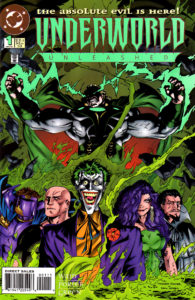
A 3-issue event series with branded tie-in one-shots and line-wide tie-in issues.
A villainous event that ran through a number of comics released in November and December 1995. Neron, a new ruler in Hell, tempts many of the DC Universes’s villains (and some of its heroes) with their greatest desires in order to do his bidding so that he may unleash the forces of Hell on Earth.
(This is at least partially made possible partially by the vacuum of power left by Superman being off-planet in his own crossover, The Trial of Superman.)
Underworld Unleashed (1995) #1-3 are collected in Underworld Unleashed paperback (1996, IBSN 978-1563894473) along Underworld Unleashed: Abyss, Hell’s Sentinel (1995) #1
In addition to the main series, DC released four Underworld Unleashed one-shots to go along with its linewide tie-in issues.
- Underworld Unleashed: Apokolips, Dark Uprising #1 (1995)
- Underworld Unleashed: Abyss, Hell’s Sentinel #1 (1995)
- Underworld Unleashed: Batman, Devil’s Asylum #1 (1995)
- Underworld Unleashed: Patterns of Fear #1 (1995)
A list of tie-in issues to come!
1996: Legends of the Dead Earth Annuals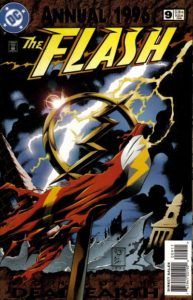
Individual stories in the same continuity told across the entire line of Annuals.
In 1996 DC repeated their Elseworlds Annuals theme with a high concept attached. “Legends of the Dead Earth” followed a central conceit that in a distant future, with Earth uninhabited and its descendants scattered amongst the stars, Martian Manhunter had spread the legend of his former hero compatriots.
While the stories rely on a single, central, future continuity for their frame, the stories themselves do not go together – having been fractured by the whisper-down-the-lane nature of oral histories retold over many years.
Click to expand list of tie-in issues1996: Final Night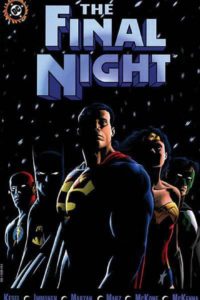
A 4-issue event series with line-wide tie-in issues.
A series where a Galactus-esque entity known as “The Sun-Eater” approaches our galaxy to devour our sun – and the combined might of DC’s heroes cannot seem to stop him!
Click to expand a reading order of tie-in issuesFinal Night (1996) #1-4 are collected in Final Night paperback (1998, ISBN 978-1563894190) along with Final Night (1996) Preview and Parallax: Emerald Night (1996) #1
1997: Pulp Heroes Annuals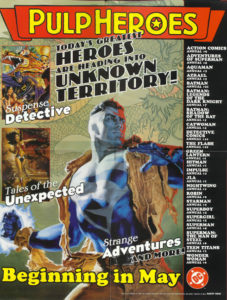
Individual stories in different continuities told across the entire line of Annuals.
DC continued their out-of-continuity annuals in 1997 with “Pulp Heroes,” a theme that found the entire line of annuals mimicking the covers of 1930s pulp magazines and the noir stories within.
These annuals don’t form a cohesive story and have not been collected comprehensively.
Click to expand list of tie-in issues1997: Genesis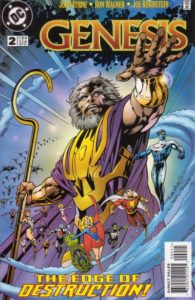
A 4-issue event series with line-wide tie-in issues.
An event series penned by John Byrne during his run on Wonder Woman that sought to define the creation of both DC’s gods and heroes through a “God Wave” echoing across the galaxy, with Darkseid at the center of conflict.
Genesis #1-4 have not been collected.
Click to expand a reading order of tie-in issues1998: Ghosts Annuals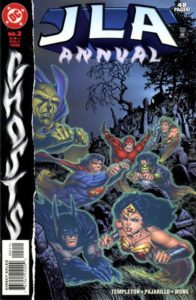
Individual stories in the same continuity told across the entire line of Annuals.
After several years of successful out-of-continuity annuals events, DC returned to an in-continuity story while still avoiding a direct crossover. Ghosts featured the apparitions of defeated friends and foes coming back to haunt our heroes.
Only the core JLA-related heroes participated in this event. It does not have a specific reading order and has not been collected comprehensively.
- Aquaman (1994) Annual 4
- Batman Annual 22
- The Flash (1987) Annual 11
- Green Lantern (1990) Annual 7
- Martian Manhunter (1998) Annual 1
- JLA Annual 2
- Superman (1987) Annual 10
- Wonder Woman (1987) Annual 7
1998: DC One Million
A story told via line-wide one-shots, a 4-issue series, and a 80-Page Giant finale.
A story that reached from 1998 to the 853rd century, when DC would publish the millionth issues of its line of titles.
This Grant Morrison story saw the future Justice League visiting that of the present day in the spirit of celebration before the entirety of time is put at risk by Vandal Savage.
Click to expand a reading order of tie-in issues
This event is collected in full in the DC One Million Omnibus hardcover (2013, ISBN 978-1401242435) – DC One Million #1-4 and 80-Page Giant, Superman / Batman #79-80, and the following #1,000,000 one-shots: Action Comics, Adventures of Superman, Aquaman, Azrael, Batman, Batman: Shadow of the Bat, Booster Gold (a retcon published a decade later), Catwoman, Chase, Chronos, Creeper, Detective Comics, Flash, Green Arrow, Green Lantern, Hitman, Impulse, JLA, Legion of Super-Heroes, Legionnaires, Lobo, Martian Manhunter, Nightwing, Power of Shazam, Resurrection Man, Robin, Starman, Superboy, Supergirl, Superman, Superman: The Man of Steel, Superman: The Man of Tomorrow, Wonder Woman, Young Heroes in Love, Young Justice
A 1998 DC One Million paperback (ISBN 978-1563895258) collected DC One Million (1998) #1-4 and the one-shots from Detective Comics, Green Lantern, JLA, Resurrection Man, Starman, and Superman: The Man of Tomorrow.
#4
1999: Day of Judgment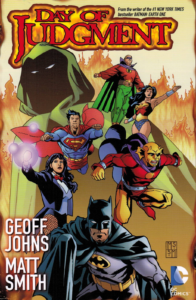
A 4-issue event series with two one-shots and line-wide tie-in issues.
An event focused on Etrigan the Demon and the Spectre which resulted in a major change of status (and beginning of redemption) for Hal Jordan.
Click to expand a reading order of tie-in issuesDay of Judgment (1999) #1-5 are collected in Day of Judgment paperback (2013, ISBN 978-1401237950) along with Day of Judgment Secret Files (1999) #1
1999: JLApe: Gorilla Warfare!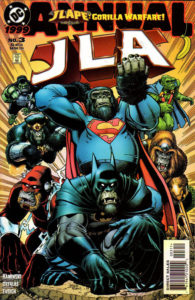
A direct crossover between Annuals.
A lightweight annuals crossover featuring Gorilla City declaring war on humanity after their president is assassinated.
Their weapon of choice? Causing humans and their heroes to go ape – that is, turning them into apes sympathetic to their cause. And, they start with … The Justice League!
JLApe has not been reprinted, although some individual annuals may have been collected along with their individual series.
Though the annuals were not visibly numbered, each story ended with a tag that identified the next annual in sequence.
Click to expand a reading order of tie-in issues2000: Silver Age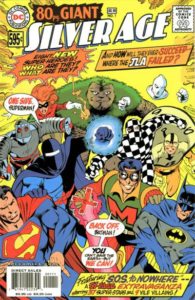
A series of twelve one-shots.
A series of sequential one-shots penned by Mark Waid and a rotation of DC’s other writers. Though telling a modern story, these issues were styled in the manner of Silver Age comics – from their art and graphic design to their scripting style.
Click to expand a reading order of tie-in issuesSilver Age has not been collected
2000: Planet DC Annuals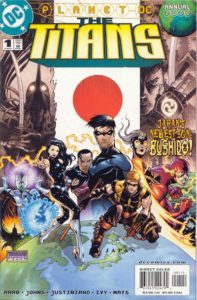
Individual stories in the same continuity told across the entire line of Annuals.
In 2000 DC returned to a central Annuals theme with no direct crossover. Each Annual story featured a new, international superhero. The event does not have a specific reading order and has not been collected comprehensively.
- Batgirl (2000) Annual 1
- Batman (1940) Annual 24
- The Flash (1987) Annual 13
- Green Lantern (1990) Annual 9
- JLA (1997) Annual 4
- JSA (1999) Annual 1
- Superman (1987) Annual 12
- The Titans (1999) Annual 1
2001: Our Worlds at War
An indirect crossover story in Superman and Wonder Woman titles with linewide one-shots.
A world-invasion story told over the course of three months. Issues were released in weekly waves that proceeded roughly in chronological order. Some issues indicated the specific next issues to read in sequence.
Click to expand a list of tie-in issues Click to expand a reading order of tie-in issues
Superman: Our Worlds at War paperback (2006, IBSN 978-1401211295) collects the main spine of the story in a single volume – Action Comics (1938) #780-782, Adventures of Superman (1987) #593-595, Impulse (1995) #77, JLA: Our Worlds at War (2001) #1, Superboy (1994) #91, Supergirl (1996) #59, Superman (1987) #171-173, Superman: The Man of Steel (1991) #115-117, Wonder Woman (1987) #172-173, World’s Finest: Our Worlds at War (2001) #1, Young Justice (1998) #36
Two prior volumes contained the same contents:
Superman: Our Worlds at War – Book One (2002, ISBN 978-1563899157) collects Action Comics (1938) #780-781, Adventures of Superman (1987) #593-594, JLA: Our Worlds at War (2001) #1, Supergirl (1996) #59, Superman (1987) #171-172, Superman: The Man of Steel (1991) #115-116
Superman: Our Worlds at War – Book Two (2002, ISBN 978-1563899164) collection collects Action Comics (1938) #782, Adventures of Superman (1987) #595, Impulse (1995) #77, Superboy (1994) #91, Superman (1987) #173, Superman: The Man of Steel (1991) #117, Wonder Woman (1987) #172-173, World’s Finest: Our Worlds at War (2001) #1, and Young Justice (1998) #36
2001-02: Joker: Last Laugh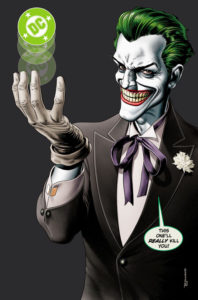
A 6-issue limited series with line-wide tie-in issues.
When an imprisoned Joker learns he has a terminal condition he decides to go out laughing. He engineers an increasingly (and ludicrously) complex plot that escalates from a prison break to hiding in a black hole while poisoning the entire world.
Click to expand a reading order of tie-in issuesJoker: Last Laugh #1-6 are collected in Batman: Joker’s Last Laugh (2008, 978-1401217846). It does not include and Joker: Last Laugh Secret Files [and Origins] #1.
2004: Identity Crisis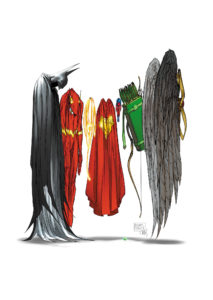
A 7-issue event series with limited tie-in stories.
Despite invoking the family “crisis” name, Identity Crisis was a considerably more cerebral and less-sprawling affair than the original Crisis two decades prior.
In keeping with its name, it focuses on the concept of identity – including just how far heroes might go to protect their own. Violence against women figures heavily into the plot, including sexual violence, some of which is depicted graphically on the page.
Click to expand a list of tie-in issues Click to expand a reading order of tie-in issuesFor more on the comic trope of women in mortal peril to motivate male heroes, see Gail Simone’s classic web site Women in Refrigerators.
If you have been the victim of domestic or sexual violence, there are organizations that exist to support you. Contact The National Domestic Violence Hotline @ 1-800-799-7233 or RAINN @ #1-800-656-HOPE.
Identity Crisis #1-7 has been collected in Absolute (2011, ISBN 978-1401232580), 10th anniversary deluxe hardcover (2014, ISBN 978-1401252786), hardcover (2005, ISBN 978-1401206888), paperback (ISBN 978-1401204587), and 2016 paperback (ISBN 978-1401263133) editions.
2005: Countdown to Infinite Crisis – Day of Vengeance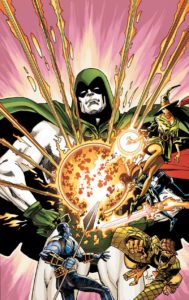
A 6-issue mini-series with a follow-up one-shot and several tie-ins that is part of the lead-up to Infinite Crisis.
Day of Vengeance is an outcome of of Identity Crisis. as well as of Green Lantern: Rebirth #1-6, which separated The Spectre from Hal Jordan. It is one of four prologue events to Infinite Crisis.
Day of Vengeance (2005) #1-6 are collected in Day of Vengeance paperback (2005, ISBN 978-1401208400) along with the “Lightning Strikes” crossover from Action Comics (1938) #826, Adventures of Superman (1987) #639, and Superman (1987) #216.
Those issues are also collected in full in Infinite Crisis Omnibus (detailed below).
The subsequent Day of Vengeance Special occurs after Infinite Crisis #2 and is collected alongside Infinite Crisis, below.
Click to expand a reading order of all tie-in issues2005: Countdown to Infinite Crisis – The OMAC Project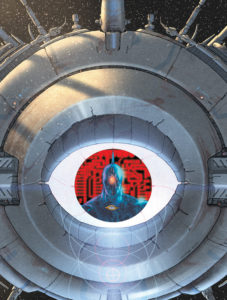
A 6-issue mini-series with a follow-up one-shot and several tie-ins that is part of the lead-up to Infinite Crisis.
Omac Project is one of four prologue events to Infinite Crisis. The story of a literal and figurative watchful eye ties in with Batman’s response to Identity Crisis and heavily features DC’s trinity of Wonder Woman, Batman, and Superman.
It begins about halfway through Day of Vengeance (after #4). The Countdown to Infinite Crisis one-shot leads into the event.
The OMAC Project (2005) #1-6 are collected in The OMAC Project paperback (2005, ISBN 978-1401208370) along with prologue material from Countdown to Infinite Crisis (2005) #1 and tie-in Wonder Woman (1987) #219.
Those issues are also collected in full in Infinite Crisis Omnibus (detailed below).
Superman: Sacrifice paperback (2006, 978-1401209193) collects tie-ins from Superman #218-220, Adventures Of Superman #642-643, Action Comics #829, and Wonder Woman #219-220. These issues are not collected in the Infinite Crisis Omnibus
The subsequent O.M.A.C. Project Special fits between Infinite Crisis #6-7 and is collected alongside Infinite Crisis, below.
Click to expand a reading order of all tie-in issues2005: Countdown to Infinite Crisis – Villains United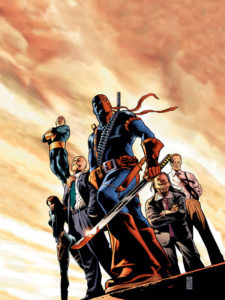
A 6-issue mini-series with a follow-up one-shot and several tie-ins that is part of the lead-up to Infinite Crisis.
A story spinning out of Lex Luthor’s secret plot against superheroes while president and leading into the 2006 volume of Secret Six.
This is part of the lead-in to Infinite Crisis and occurs roughly equivalent to the beginning of Countdown. It begins after OMAC Project concludes.
(I am unclear on if The Return of Donna Troy #1-4 come directly before or directly after this – if you’re sure, you’re clarification would be appreciated!)
Villains United (2005) #1-6 are collected in Villains United paperback (2005, ISBN 978-1401208387).
Those issues are also collected in full in Infinite Crisis Omnibus (detailed below).
It was subsequently re-collected in Secret Six, Vol. 1: Villains United (2015, ISBN 978-1401250751) along with Villains United (2005) Infinite Crisis Special and Secret Six (2006) #1-6.
The subsequent Villains United Special fits between Infinite Crisis #6-7 and is collected alongside Infinite Crisis, below.
Click to expand a list of official tie-in issues Click to expand a reading order of all tie-in issues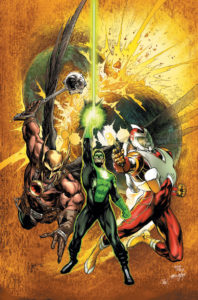 2005: Countdown to Infinite Crisis – Rann-Thanagar War
2005: Countdown to Infinite Crisis – Rann-Thanagar War
A 6-issue mini-series with a follow-up one-shot and several tie-ins that is part of the lead-up to Infinite Crisis.
The Ran-Thanagar War continues storylines from Adam Strange: Planet Heist and Green Lantern: Rebirth. It is a redux of a pre-Crisis DC story that had Strange’s planet, Rann, in continuous conflict with the home of Hawkman, Thanagar.
This is the last of the Countdown Events, and occurs after the end of Villains United.
Green Lantern: Rebirth #1-6 has been collected in Absolute (2010, ISBN 978-1401225742), hardcover (2005, ISBN 978-1401207106), 2010 paperback (ISBN 978-1401227555), and 2007 paperback (ISBN 978-1401204655).
Adam Strange #1-8 are collected in Adam Strange: Planet Heist paperback (2005, ISBN 978-1401207274)
Rann/Thanagar War (2005) #1-6 are collected in Rann/Thanagar War paperback.
Those issues are also collected in full in Infinite Crisis Omnibus (detailed below).
The subsequent Rann/Thanagar War Special occurs before Infinite Crisis #2 and is collected alongside Infinite Crisis, below.
2005-06: Infinite Crisis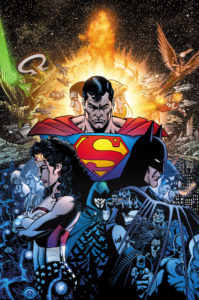
A 7-issue limited series with line-wide tie-ins.
Infinite Crisis finds the DC Universe fractured by the events of its four lead-in series and DC’s Trinity of Wonder Woman, Batman, and Superman fractured by story elements beginning in Identity Crisis.
Into this chaos, a number of pre-Crisis characters shelved since Crisis on Infinite Earths return – each with a competing priority for our primary earth and its heroes.
Absolute Infinite Crisis hardcover (2016, ISBN 978-1401265359) collects Infinite Crisis (2005) #1-7 and material from the original hardcover.
Infinite Crisis #1-7 were originally collected in hardcover and paperback.
Infinite Crisis Omnibus hardcover (2012, ISBN 978-1401235024) collects the event series along with all four of its lead-in events, as described above and an arc of JLA (1997) and Infinite Crisis Secret Files 2006.
In total, it collects Action Comics (1938) #826 & 829, Adventures of Superman (1987) #639 & 642, Countdown to Infinite Crisis (2005) #1, Day of Vengeance (2005) #1-6 & Infinite Crisis Special, Infinite Crisis (2005) #1-7 & material from the hardcover, Infinite Crisis Secret Files 2006 (2006) #1, JLA (1997) #115-119, The OMAC Project (2005) #1-6 & Infinite Crisis Special, Rann/Thanagar War (2005) #1-6 & Infinite Crisis Special, Superman (1987) #216 & 219, Villains United (2005) #1-6 & Infinite Crisis Special, and Wonder Woman (1987) #219
Crisis Aftermath: The Battle for Blüdhaven (2006, ISBN 978-1401211998) collects a 6-issue limited series of the same name.
For more on the Infinite Crisis and reading order, see the fantastic Complete Infinite Crisis.
Click to expand a list of tie-in issues
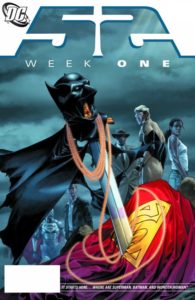 2006-08: Trinity, 52, and One Year Later
2006-08: Trinity, 52, and One Year Later
A pair of year-long weekly series and a linewide story theme.
Directly after Infinite Crisis, DC’s entire line leapt forward twelve months in a change of status quo called One Year Later. It lead to the relaunch of some titles and radical changes of direction on others.
What happened in the lost year? Wonder Woman, Batman, and Superman disappeared from public view, leaving a power vacuum in the DC Universe.
That vacuum was explored in real time by 52, a weekly anthology series that launched in the wake of Infinite Crisis in May 2006. Over the course of a year, it caught up to the status quo from the beginning of One Year Later. Notably, it introduced Batwoman!
What happened to DC’s trinity of iconic superheroes? That, too, merited a 52-issue weekly title, called Trinity, which launched in June of 2008. Chronologically, Trinity occurs side-by-side with 52, with both ending just prior to One Year Later.
Click to expand a list of the first issue of each One Year Later tie-in52 (2006) #1-52 has been collected in a single 52 Omnibus hardcover (2012, ISBN 978-1401235567), in 2016 in two halves as Book 1 (2016 paperback, ISBN 978-1401263256 / 2024 paperback, ISBN 978-1779525857 / digital) and Book 2, and originally as #1-13 in Volume 1, #14-26 in Volume 2, and #27-39 in Volume 3, and #40-52 in Volume 4. Many of 52’s characters and stories continue to Countdown, below.
Prior stories establishing the heroes appearing in 52 are collected in 52 Companion – Animal Man (1988) #16, Detective Comics (1937) #350, Gotham Central (2003) #40, JSA (1999) #43-44, Metal Men (1963) #45, Mysterious Suspense (1968) #1, Rip Hunter…Time Master (1961) #6, Secret Origins (1986) #35, Strange Adventures (1950) #226, Superman: The Man of Steel (1991) #97
A 3-issue mini-event titled World War III occurred in Week 50 of 52 and is collected as DC: World War 3 along with 52 (2006) #50.
Trinity (2008) #1-52 has been collected as #1-17 in Volume 1, #18-35 in Volume 2, and #36-52 in Volume 3.
52 Aftermath: The Four Horsemen #1-6 was published after 52 and before Trinity. It shows the Trinity’s actions in the week of their year away. It is collected in 52 Aftermath: The Four Horsemen.
2007: Amazons Attack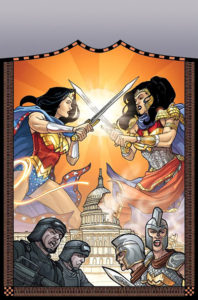
A 6-issue limited series with a lead-up story in Wonder Woman and tie-ins in four titles.
Amazons Attack spins out of the beginning of Wonder Woman’s post Infinite Crisis status quo, bringing The Amazons out of hiding and into man’s world to attack the United States. It was not well-received by fans and critics.
Click to expand a reading order of tie-in issuesAmazons Attack (2007) #1-6 are collected in Amazons Attack paperback (2006, ISBN 978-1401217327)
Wonder Girl (2007) #1-6 spun out of this series and are collected in Teen Titans Spotlight: Wonder Girl.
2008-09: Final Crisis
A 7-issue event series with a lengthy lead-in and multiple tie-in and aftermath mini-series.
In 2008, Grant Morrison tied up not only several years of his own plot threads but several decades of DC continuity into the epic Final Crisis.
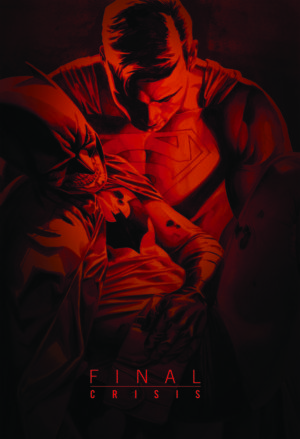 Unlike Infinite Earths, Zero Hour, and Infinite Crisis before it, Final Crisis was less concerned with fixing DC’s complex layers of continuity as it was in mining them. It brought Jack Kirby’s New Gods to the fore of the story. It also serves as pivotal point in Morrison’s Batman epic – with the caped crusader in an improbable 1-on-1 showdown with Darkseid.
Unlike Infinite Earths, Zero Hour, and Infinite Crisis before it, Final Crisis was less concerned with fixing DC’s complex layers of continuity as it was in mining them. It brought Jack Kirby’s New Gods to the fore of the story. It also serves as pivotal point in Morrison’s Batman epic – with the caped crusader in an improbable 1-on-1 showdown with Darkseid.
Before the event came the Countdown – another weekly series but also a number of related mini-series and one-shots.
Click to expand a list of Countdown tie-in issues and other Final Crisis lead-insCountdown [to Final Crisis] #51-0 acted as a lead-in to the event, although in retrospect it is seen as less than successful. They are collected as #51-39 in Volume 1, #38-26 in Volume 2, #25-13 in Volume 3, and #12-1 in Volume 4.
A related series of one-shots are collected in Countdown Presents: The Search for Ray Palmer
Absolute Final Crisis hardcover (2012) collects Final Crisis #1-7, Final Crisis: Submit #1, Final Crisis Superman Beyond #1-2 and material from Final Crisis Sketchbook (2008) #1 and Final Crisis: Secret Files (2009) #1.
Final Crisis #1-7 are collected in 2014 paperback and 2010 paperback along with DC Universe (2008) #0, Final Crisis: Submit (2008) #1, and Final Crisis: Superman Beyond (2008) #1-2. The 2014 version adds pages from Batman (1940) #682-683.
Aside from its connection to Batman, Final Crisis was a remarkably contained line-wide event. While many titles participated in its countdown, none aside from Batman and a single Justice Society issue tied in during the event.
Click to expand a list of Final Crisis tie-in issuesThat makes for a lot of prelude and tie-in material. Do you have to read it all? No! Here’s the semi-official reading order, based on this Newsarama interview with Morrison.
Click to expand the condensed reading orderLooking for the fuller reading order? I’m still working on it, but you can see my notes.
Click to expand my notes on a fuller reading orderFinally (seriously, for an event named Final Crisis this one just won’t end!), there were a number of Final Crisis Aftermath series and arcs.
Click to expand a list of aftermath issuesMy references for this section include Reddit, Comics Alliance, and Quora
2009-10: Blackest Night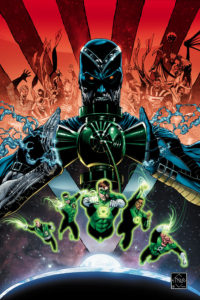
A 8-issue event series with direct crossovers into the Green Lantern titles, tie-in limited series and indirect crossovers across all lines.
In 2009 Geoff Johns continued his Green Lantern epic with some additive color theory, bringing together the newly introduced color spectrum of lanterns against the threat of Nekron.
With his black power rings, he was able to both reanimated deceased heroes and corrupt some of the strongest heroes on Earth – like Superman and Wonder Woman.
Blackest Night ran through Blackest Night (2009) #0-8, Green Lantern (2005) #44-52, and Green Lantern Corps #39-47. A prelude story ran across Final Crisis: Rage of the Red Lanterns & Green Lantern #35-43.
Click to expand the core reading order Click to expand a list of tie-in issuesAbsolute Blackest Night hardcover (2013, ISBN 978-1401240738) collects the core Blackest Night and Green Lantern issues (but not Green Lantern Corps) – Blackest Night (2009) #0-8, Blackest Night Director’s Cut (2010) #1, DC Universe (2008) #0, Green Lantern (2005) #43-52, and Untold Tales of Blackest Night (2010) #1
Green Lantern by Geoff Johns Omnibus Vol. 2 hardcover (2015, ISBN 978-1401255268) collects the full lead-up to the event from Green Lantern as well as the Tales of the Corps tie-in series – Blackest Night (2009) #0-8, Blackest Night: Tales of the Corps (2009) #1-3, DC Universe (2008) #0, Final Crisis: Rage of the Red Lanterns (2008) #1, Green Lantern (2005) #26-52, and Untold Tales of Blackest Night (2010) #1
Blackest Night (hardcover / paperback) collects Blackest Night (2009) #0-8 and Blackest Night Director’s Cut (2010) #1.
The prelude material is collected as Green Lantern (2005) #26-28 & #36-38 and Final Crisis: Rage of the Red Lanterns in Green Lantern, Vol. 5: Rage of the Red Lanterns (hardcover / paperback) and Green Lantern (2005) #39-42 and Blackest Night (2009) #0 in Green Lantern, Vol. 6: Agent Orange (hardcover / paperback) from Green Lantern #35-42 &
Green Lantern #43-52 are collected in Green Lantern, Vol. 7: Blackest Night (hardcover / paperback)
Green Lantern Corps (2006) #39-47 are collected in Green Lantern Corps, Vol. 6: Blackest Night (hardcover / paperback).
2010-11: Brightest Day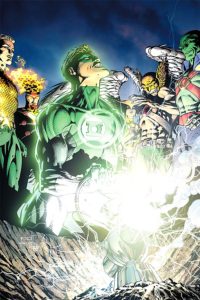
A 24-issue weekly event series with indirect crossover issues across all lines.
Brightest Day was a weekly series that followed a dozen heroes and villains who were resurrected at the end of Blackest Night for unknown reasons.
Some of those heroes also starred in other ongoing titles (and not just Lanterns titles), and their own issues were interwoven with the spine of the weekly story.
Brightest Day (2010) #0-24 are collected in Brightest Day Omnibus hardcover (2014, ISBN 978-1401245979).
They were previously collected in a series of three books – #0-7 in Volume 1 (hardcover / paperback), #8-16 in Volume 2 (hardcover / paperback), and #17-24 in Volume 3 (hardcover / paperback)
A series of three prestige-format issues titled DC Comics Presents: Brightest Day (2010) #1-3 collected background material.
Brightest Day: The Atom Special (2010) #1 is not collected; it continues to Adventure Comics #516.
Brightest Day Aftermath – The Search For Swamp Thing #1-3 are not collected
Brightest Day was not an explicit direct crossover, but fans have generally come to agreement on a threaded reading order.
Click to expand a reading order of tie-in issues2011: Flashpoint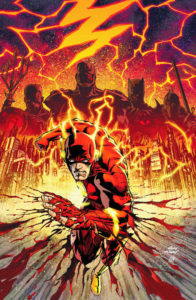
A 5-issue series that was the centerpiece of a line-wide break in continuity filled by various mini-series and followed by the relaunch of all titles.
A prologue from The Flash (2011) #8-12 are collected in The Flash Vol. 2: The Road to Flashpoint (hardcover / paperback)
Flashpoint #1-5 are collected in hardcover (2011, ISBN 978-1401233372) and paperback (2012, ISBN 978-1401233389)
Flashpoint: The World Of Flashpoint, featuring Batman (2012, ISBN 978-1401234058) collects Batman: Knight Of Vengeance #1-3, Deadman And The Flying Graysons #1- 3, Deathstroke And The Curse Of The Ravager #1-3, and Secret Seven #1-3.
Flashpoint: The World of Flashpoint, featuring Green Lantern (2012, ISBN 978-1401234065) collects Flashpoint: Abin Sur – The Green Lantern #1-3, Flashpoint: Frankenstein and the Creatures of the Unknown #1-3, Flashpoint: Green Arrow Industries #1, Flashpoint: Hal Jordan #1-3
Flashpoint: World Of Flashpoint, featuring The Flash (2012, ISBN 978-1401234089) collects Grodd Of War #1, Kid Flash Lost #1-3, Legion Of Doom #1-3, Reverse Flash #1, and Citizen Cold #1-3.
Flashpoint: World Of Flashpoint, featuring Superman (2012, ISBN 978-1401234348) collects World Of Flashpoint #1-3, Booster Gold #44-47, The Canterbury Cricket #1, and Project Superman #1-3
Flashpoint World Of Flashpoint Wonder Woman (and Aquaman) (2012, ISBN 978-1401234102) collects Emperor Aquaman #1- 3, Outsider #1-3, Lois Lane And The Resistance #1-3, and Wonder Woman and The Furies #1-3